
A nuclear bunker buster, also known as an earth-penetrating weapon (EPW), is the nuclear equivalent of the conventional bunker buster. The non-nuclear component of the weapon is designed to penetrate soil, rock, or concrete to deliver a nuclear warhead to an underground target. These weapons would be used to destroy hardened, underground military bunkers or other below-ground facilities. An underground explosion releases a larger fraction of its energy into the ground, compared to a surface burst or air burst explosion at or above the surface, and so can destroy an underground target using a lower explosive yield. This in turn could lead to a reduced amount of radioactive fallout. However, it is unlikely that the explosion would be completely contained underground. As a result, significant amounts of rock and soil would be rendered radioactive and lofted as dust or vapor into the atmosphere, generating significant fallout.

The Special Atomic Demolition Munition (SADM), also known as the XM129 and XM159 Atomic Demolition Charges, and the B54 bomb was a nuclear man-portable atomic demolition munition (ADM) system fielded by the US military from the 1960s to 1980s but never used in combat.
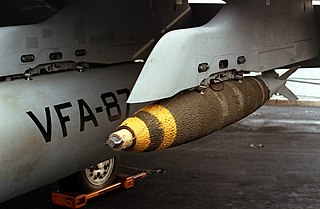
An unguided bomb, also known as a free-fall bomb, gravity bomb, dumb bomb, or iron bomb, is an aircraft-dropped bomb that does not contain a guidance system and hence simply follows a ballistic trajectory. It includes all aircraft bombs in general service until the latter half of World War II, and the vast majority until the late 1980s, which were known simply as "bombs".

The W25 was a small nuclear warhead that was developed by the Los Alamos Scientific Laboratory for air-defense use. It was a fission device with a nominal yield of 1.7 kt.

The B83 is a variable-yield thermonuclear gravity bomb developed by the United States in the late 1970s that entered service in 1983. With a maximum yield of 1.2 megatonnes of TNT (5.0 PJ), it has been the most powerful nuclear weapon in the United States nuclear arsenal since October 25, 2011 after retirement of the B53. It was designed by Lawrence Livermore National Laboratory.

The B61 nuclear bomb is the primary thermonuclear gravity bomb in the United States Enduring Stockpile following the end of the Cold War. It is a low-to-intermediate yield strategic and tactical nuclear weapon featuring a two-stage radiation implosion design.

The B43 was a United States air-dropped variable yield thermonuclear weapon used by a wide variety of fighter bomber and bomber aircraft.
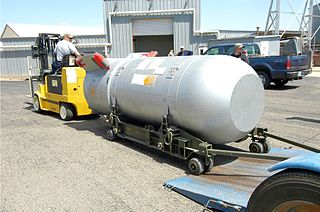
The Mk/B53 was a high-yield bunker buster thermonuclear weapon developed by the United States during the Cold War. Deployed on Strategic Air Command bombers, the B53, with a yield of 9 megatons, was the most powerful weapon in the U.S. nuclear arsenal after the last B41 nuclear bombs were retired in 1976.

The B28, originally Mark 28, was a thermonuclear bomb carried by U.S. tactical fighter bombers, attack aircraft and bomber aircraft. From 1962 to 1972 under the NATO nuclear weapons sharing program, American B28s also equipped six Europe-based Canadian CF-104 squadrons known as the RCAF Nuclear Strike Force. It was also supplied for delivery by UK-based Royal Air Force Valiant and Canberra aircraft assigned to NATO under the command of SACEUR. In addition, certain U.S. Navy carrier based attack aircraft such as the A3D Skywarrior, A4D Skyhawk, and A3J Vigilante were equipped to carry the B28.

The B-41 was a thermonuclear weapon deployed by the United States Strategic Air Command in the early 1960s. It was the most powerful nuclear bomb ever developed by the United States, with a maximum yield of 25 megatons of TNT. A top secret document, states “The US has stockpiled bombs of 9 MT and 23 MT...” which would likely be referring to the B-41's actual yield(s). The B-41 was the only three-stage thermonuclear weapon fielded by the U.S.
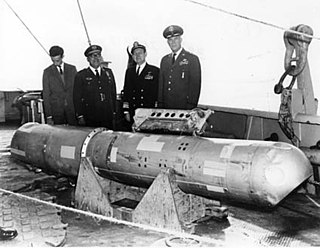
The 1966 Palomares B-52 crash, also called the Palomares incident, occurred on 17 January 1966, when a B-52G bomber of the United States Air Force's Strategic Air Command collided with a KC-135 tanker during mid-air refueling at 31,000 feet (9,450 m) over the Mediterranean Sea, off the coast of Spain. The KC-135 was destroyed when its fuel load ignited, killing all four crew members. The B-52G broke apart, killing three of the seven crew members aboard.
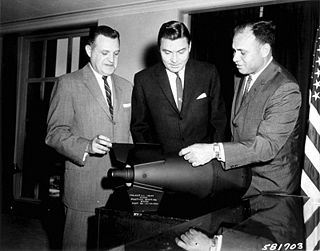
The W54 was a tactical nuclear warhead developed by the United States in the late 1950s. The weapon is notable for being the smallest nuclear weapon in both weight and yield to have entered US service. It was a compact implosion device containing plutonium-239 as its fissile material, and in its various versions and mods it had a yield of 10 to 1,000 tons of TNT.
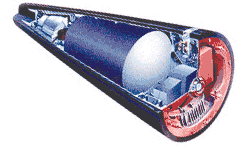
The W76 is an American thermonuclear warhead, designed for use on the UGM-96 Trident I submarine-launched ballistic missiles (SLBMs) and subsequently moved to the UGM-133 Trident II as Trident I was phased out of service. The first variant, the W76 mod 0 (W76-0) was manufactured from 1978 to 1987, and was gradually replaced by the W76 mod 1 (W76-1) between 2008 and 2018, completely replacing the Mod 0 in the active stockpile. In 2018 it was announced that some Mod 1 warheads would be converted to a new low-yield W76 mod 2 (W76-2) version. The first Mod 2 warheads were deployed in late 2019.

Mark 7 "Thor" was the first tactical fission bomb adopted by US armed forces. It was also the first weapon to be delivered using the toss method with the help of the low-altitude bombing system (LABS). The weapon was tested in Operation Buster-Jangle. The Mark 7 was fitted with retractable stabilizer fins so it could be carried under fighter-bomber aircraft. The Mark 7 warhead (W7) also formed the basis of the 30.5 inches (775 mm) BOAR rocket, the Mark 90 Betty nuclear depth charge, MGR-1 Honest John rocket, MGM-5 Corporal ballistic missile, and Nike Ajax surface-to-air missile. It was also supplied for delivery by Royal Air Force Canberra aircraft assigned to NATO in Germany under the command of SACEUR. This was done under the auspices of Project E, an agreement between the United States and the UK on the RAF carriage of US nuclear weapons. In UK use it was designated 1,650 lb. H.E. M.C. The Mark 7 was in service from 1952 to 1967(8) with 1700–1800 having been built.

The W58 was an American thermonuclear warhead used on the Polaris A-3 submarine-launched ballistic missile. Three W58 warheads were fitted as multiple warheads on each Polaris A-3 missile.

The Mark 39 nuclear bomb and W39 nuclear warhead were versions of an American thermonuclear weapon, which were in service from 1957 to 1966.

The W59 was an American thermonuclear warhead used on some Minuteman I ICBM missiles from 1962 to 1969, and planned to be used on the cancelled GAM-87 Skybolt air-launched ballistic missile.

The W73 was a planned nuclear warhead for the AGM-53 Condor air to surface missile and designed by Los Alamos Scientific Laboratory. The W73 warhead was cancelled in 1970 in favor of a purely conventional warhead for Condor. Condor was approved for production in 1975 with a expected production run of 250 missiles, but was cancelled in early 1976 due to high cost.
The B77 was a nuclear bomb designed in 1974 to match the delivery capabilities of the B-1A bomber. This included the ability to be dropped from supersonic speeds at altitudes of 60,000 feet (18,000 m), or in a laydown delivery at high subsonic speeds at altitudes as low as 100 feet (30 m). Meant to replace the Mk 28 and Mk 43 in the strategic role, the program was cancelled in December 1977 due to rising costs and the cancellation of the bomber it had been designed to serve. Many components of the B77 including its already tested physics package were incorporated in the B83 which was developed in its place.

The 1961 Goldsboro B-52 crash was an accident that occurred near Goldsboro, North Carolina, United States, on 24 January 1961. A Boeing B-52 Stratofortress carrying two 3.8-megaton Mark 39 nuclear bombs broke up in mid-air, dropping its nuclear payload in the process. The pilot in command, Walter Scott Tulloch, ordered the crew to eject at 9,000 ft (2,700 m). Five crewmen successfully ejected or bailed out of the aircraft and landed safely; another ejected, but did not survive the landing, and two died in the crash. Information declassified since 2013 has shown that one of the bombs was judged by nuclear weapons engineers at the time to have been only one safety switch away from detonation, and that it was "credible" to imagine conditions under which it could have detonated.



















